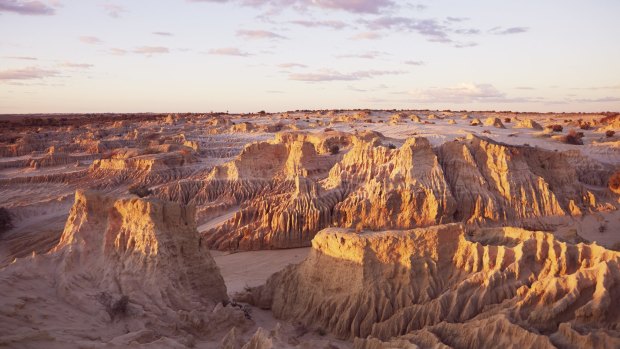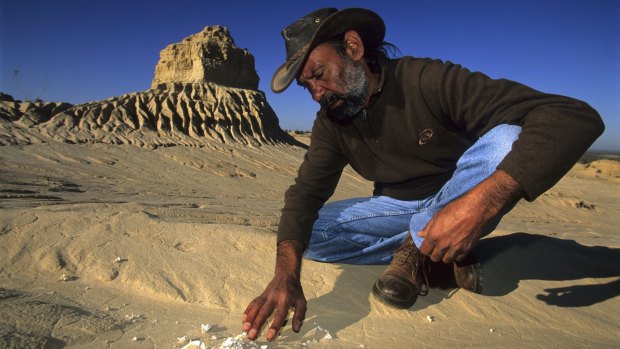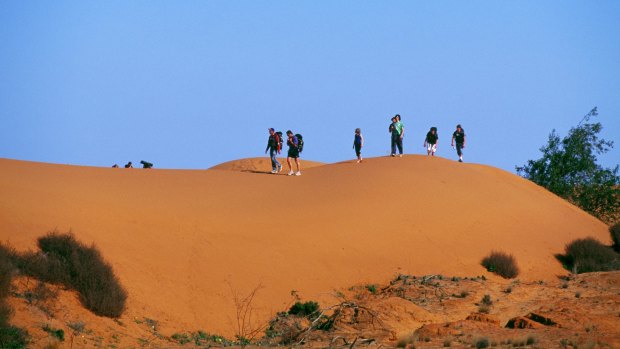This was published 7 years ago
Visit the Australian Outback: Mungo National Park, Harry Nanya day tour

The lunar-like landscape of Mungo National Park.
"My people wouldn't have eaten the apple. They'd have eaten the snake."
Graham Clarke's take on the Garden of Eden story is typical – it comes from an unexpected angle, challenges orthodoxy and ends up making complete sense.
This flurry of perception-changing pronouncements comes on the sands where common assumptions about life in Australia were radically overhauled.

A guide points out partially buried bones in Mungo National Park.
In July 1968, Dr Jim Bowler from the Australian National University discovered human remains at the southern end of Lake Mungo in the NSW outback. Carbon dating revealed that they were of a woman whose bones had been burned, crushed and buried more than 26,000 years ago. To date, Mungo Lady is the oldest cremated human ever found.
Then, in 1974, less than 500 metres away, a full skeleton became exposed by the elements, with pink-coloured ochre scattered over it, hinting at ritual burial. Mungo Man turned out to be at least 30,000 years old (with the precise date hotly disputed). And further investigation of stone weapons and buried fireplaces show that Aboriginal people have lived continuously in the Mungo area for about 50,000 years.
Before these discoveries, it was assumed that Indigenous Australians arrived on the continent from about 20,000 years ago. A lot of textbooks got ripped up, and Clarke would quite like to see a few more go the same way.

On tour in Mungo National Park.
He has been operating Harry Nanya tours to the Mungo National Park for more than two decades. In that time, he has seen the landscape move, with yet more remains and fossils uncovered by wind and rain erosion. The prevailing westerlies have blown dune-like structures of sand, clay and sediment ("lunettes") steadily further east, uncovering more blasts from the past in their wake. Layers in the outcrops tell myriad stories, and what look like small rocks often prove to be calcified, fossilised tree branches. A seemingly barren landscape holds many secrets.
It won't always be like this – the region was once green and bountiful – but about 20,000 years ago the Lachlan River shrank back and the lake dried out. Although Clarke disputes that it has been dry since this time. "It fills every 700 to 900 years, and I know that because my grandmother told me. And she knows because it has been passed down through the generations."
The freshwater mussel shells that are among the more recent revelations from the moving lunettes seem to prove Clarke's grandmother correct.
Time is a concept that Clarke gets very vociferous about. We are, apparently, forced into man-made clocks and calendars that don't fit nature's. Spring is now arriving in July, he says – that's when the flowers will start appearing.
He draws in the sand to illustrate nature's climate cycles. The shortest cycle is day and night, with each 24-hour period having its own spring, summer, autumn and winter.
The next cycle is a year, but there is one that we ignore of 100 years, and that, too, has its 25-year blocks of spring, summer, autumn and winter. Australia is experiencing its summer on the 100-year cycle, hence the long droughts, and is coming into autumn.
Then there is a 100,000-year cycle, which coincides with the earth tilting on its axis. Again, the southern hemisphere is coming into autumn, and climates will change as a result. Sea levels rising, and crocodiles and cyclones moving south are all part of this. We just can't see it because we're trapped in the mindset of a one-year, consistent calendar.
All this comes among a blizzard of other strongly coherent theories and passed-down wisdom. Ever-expanding dictionaries make law too complicated, with catastrophic results. Mungo Man and Lady are much older than stated – the scientific community just needed the dates to fit the Out of Africa evolutionary theory. Modern technology is shortening the lifespan of the entire human race.
Even for the habitually sceptical, a lot sounds plausible enough – certainly convincing enough to induce a burning desire to revisit the data, the evidence and the counter-theories to the current prevailing wisdom.
By lunchtime, a tour that started with the aim of seeing spectacular outback scenery and learning about presumption-busting, World Heritage-qualifying skeletons, has turned into something very different. As the plastic salad tubs are opened, minds are whirring, mindsets have been thoroughly challenged and mental certainties are shaky.
As his audience tucks into silverside beef and smoked kangaroo by the dry lake's giant saltbush-filled bowl, the supreme storyteller kicks off again. "Now, as for the Big Bang theory …"
TRIP NOTES
MORE
DRIVE, FLY
The main three access towns for Mungo National Park are Balranald, Wentworth and Mildura, which are 163 kilometres, 132 kilometres and 114 kilometres away by dirt road respectively. Be warned: the roads are usually closed after wet weather and there is no fuel at Mungo or on the way.
If flying rather than driving, the nearest airport is in Mildura. Regional Express flies to Mildura from Sydney and Melbourne. See rex.com.au
STAY
The Mungo Lodge is just outside the Mungo National Park, and four kilometres from the visitor centre. Cabin-style rooms have a generic lower end four-star feel, a fair achievement given the remote location.
SEE + DO
The Harry Nanya day tour picks up in Mildura, Wentworth and from the visitor centre at Mungo National Park. It costs $180 with pick-up in Mildura/ Wentworth, or $90 from the visitor centre, and runs between April and October. See harrynanyatours.com.au
David Whitley was a guest of Destination New South Wales visitnsw.com
Sign up for the Traveller Deals newsletter
Get exclusive travel deals delivered straight to your inbox. Sign up now.